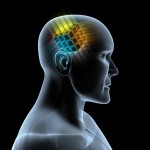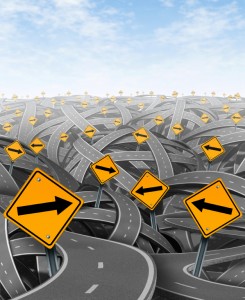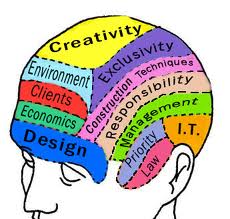What We Don’t Know and Don’t See
It’s hard to think critically when you don’t know what you’re missing. As we think about improving our thinking, we need to account for two things that are so subtle that we don’t fully recognize them:
- Assumptions – we make so many assumptions about the world around us that we can’t possibly keep track of them all. We make assumptions about the way the world works, about who we are and how we fit, and about the right way to do things (the way we’ve always done them). A key tenet of critical thinking is that we should question our own thinking. But it’s hard to question our assumptions if we don’t even realize that we’re making assumptions.
- Sensory filters – our eye is bombarded with millions of images each second. But our brain can only process roughly a dozen images per second. We filter out everything else. We filter out enormous amounts of visual data, but we also filter information that comes through our other senses – sounds, smells, etc. In other words, we’re not getting a complete picture. How can we think critically when we don’t know what we’re not seeing? Additionally, my picture of reality differs from your picture of reality (or anyone else’s for that matter). How can we communicate effectively when we don’t have the same pictures in our heads?
Because of assumptions and filters, we often talk past each other. The world is a confusing place and becomes even more confusing when our perception of what’s “out there” is unique. How can we overcome these effects? We need to consider two sets of questions:
- How can we identify the assumptions were making? – I find that the best method is to compare notes with other people, especially people who differ from me in some way. Perhaps they work in a different industry or come from a different country or belong to a different political party. As we discuss what we perceive, we can start to see our own assumptions. Additionally we can think about our assumptions that have changed over time. Why did we used to assume X but now assume Y? How did we arrive at X in the first place? What’s changed to move us toward Y? Did external reality change or did we change?
- How can we identify what we’re not seeing (or hearing, etc.)? – This is a hard problem to solve. We’ve learned to filter information over our entire lifetimes. We don’t know what we don’t see. Here are two suggestions:
- Make the effort to see something new – let’s say that you drive the same route to work every day. Tomorrow, when you drive the route, make an effort to see something that you’ve never seen before. What is it? Why do you think you missed it before? Does the thing you missed belong to a category? Are you missing the entire category? Here’s an example: I tend not to see houseplants. My wife tends not to see classic cars. Go figure.
- View a scene with a friend or loved one. Write down what you see. Ask the other person to do the same. What are the differences? Why do they exist?
The more we study assumptions and filters, the more attuned we become to their prevalence. When we make a decision, we’ll remember to inquire abut ourselves before we inquire about the world around us. That will lead us to better decisions.
Tetris On The Brain
Remember Tetris? Originally released in Russia in 1984, it became the top selling video game of all time, with more than 495 million copies in circulation. It’s a simple game – different shaped tiles fall from the top of the screen and you arrange them in patterns at the bottom of the screen.
It seems like a simple-minded time killer. It’s not rocket science. But it turns out to have some interesting effects on our brains. Here are two recent studies.
Tetris and Intrusive Memories
Lets say you’re in a car accident. The trauma, whether physical or psychological, may result in intrusive memories, which are hallmarks of post-traumatic stress disorder (PTSD).
When an intrusive memory occurs, the survivor essentially relives the traumatic event. It seems plausible that reducing intrusive memories would help survivors manage stress and maintain metal health. So, how might one reduce intrusive memories or prevent their formation in the first place? How about Tetris?
This was the hypothesis of a study recently published in Molecular Psychiatry. Researchers recruited 71 subjects in an emergency room at a hospital in Oxford, England. The subjects had recently (less then six hours previously) experienced an automobile accident and were randomly assigned to one of two groups:
- Experimental condition: play Tetris for 20 minutes in the emergency room
- Control condition: describe their activities in the emergency room in a written activity log.
Researchers contacted the subjects one week and one month after the accident. The result? Subjects who played Tetris “recorded significantly fewer intrusive memories” and “reported less distress from intrusion symptoms.”
Tetris and Your Cortex
What about people who aren’t involved in a traumatic event? Does Tetris have an impact on them? This was the question asked several years ago in a study conducted by researchers at the University of New Mexico.
The researchers recruited 26 girls, aged 12 to 15 and randomly assigned them to the experimental group or the control group. The researchers taught the girls in the experimental group to play Tetris and coached them to play regularly. The girls in the control group were coached not to play Tetris. The researchers followed the two groups for three months. During that time the girls in the Tetris group played the game approximately 90 minutes per week.
At the end of three months, the Tetris-playing girls had a “significantly thicker cortex” than the non-Tetris-playing girls. The cortex is gray matter and is generally associated with higher-level brain functions such as memory, attention, and planning.
Does this mean that playing Tetris will make your smarter or your brain more efficient? Probably not. Playing Tetris probably only makes you better at playing Tetris. But it’s more evidence that the brain is plastic; you can change it by how you behave. It’s not surprising in a group of youngsters whose brains are not yet mature. It might be very telling to replicate the experiment with a group to oldsters to see just how plastic their brains are. My hypothesis: there’s still a lot of plasticity left.
So Tetris can teach us about brain plasticity and help suppress intrusive memories. Not bad for a free video game. I wonder what else it can do.
Consciousness Is A Verb

It’s not in here.
We live in an individualistic culture and I wonder if that doesn’t bias our understanding of how we behave and think. For instance, we view humans as self-contained and self-sufficient units. There’s a clear boundary between one human and another. Similarly, there’s a clear boundary between each individual and the environment around us. We are separate from each other and from the world.
But what if that’s not the case? What if humans are entangled with each other in much the same way that quantum particles are entangled? Mirror neurons are still somewhat mysterious but what if they allow us to entangle our thoughts with those of other people? Similarly, we’ve learned in the recent past that we think with our bodies as much as our brains. What if our thinking actually extends beyond our bodies and interacts with other thoughts?
Similarly, what if the environment is not separate from us but part of us? What if the environment shapes us much like a river shapes a stone? In a sense, it would mean that we’re not entities but processes. We’re not things but actions. The Buddhists might be right: impermanence is the very essence of our being.
If these things are true, it may give us a key to understanding consciousness. Defining consciousness is known as the “hard problem”. Neuroscientists often phrase the question simply: “What is consciousness?” What if that’s the wrong question? The question implies that consciousness is a thing. It also suggests that consciousness exists somewhere, most likely in the brain. But what if consciousness is not a thing but an action? What if it’s something we do as we interact with the environment? What if we’re swimming in consciousness?
You may have guessed by now that I’ve been reading the works of the philosopher, Alva Noë. (See here and here). Noë studies perception and consciousness and tries to understand how they are entangled. Noë states flatly that, “Consciousness is not something that happens in us. It is something we do.”
Noë goes on to compare consciousness to a dancer, who is influenced by myriad external factors, including the music, the dance floor, and her partner. Dancing is not within the dancer. Noë writes that, “The idea that the dance is a state of us, inside of us, or something that happens in us is crazy. Our ability to dance depends on all kinds of things going on inside of us, but that we are dancing is fundamentally an attunement to the world around us.” Similarly, Noë suggests, consciousness is not within us, rather it is “…a way of being part of a larger process.”
Noë similarly argues that consciousness is not located in a given place. The analogy is life itself. If we look at other people, we can tell that they’re alive. But where is life located in them? We quickly realize that we don’t think of life as a thing that is located in a certain place. Life is not a thing but a dynamic. Noë argues that the same is true of consciousness.
Noë also suggests that cognitive scientists are pursuing the wrong analogy – the computer. This “distinctively nonbiological approach” converts consciousness into a mere computational function that is “…very much divorced from the active life of the animal.” The active life – and engagement with the world around us – creates consciousness in a way that a “brain in a vat” could never do.
What’s it all mean? We’re looking for consciousness in all the wrong places. As Noë concludes, “…the idea that you are your brain or that the brain alone is sufficient for consciousness is really just a mantra, and … there is no reason to believe it.”
Brain Networks – Part 2

Everything is networked.
Yesterday (and in earlier articles here and here), we talked about two brain networks – default and reward – and their implications for organizational behavior. Today, let’s take on two more networks – affect and control – and see how they work in the office. Again, I’ll draw on a recent HBR article by Adam Waytz and Malia Mason.
The affect network activates when people experience emotions. You might think that we consciously recognize something and then feel some emotion about it. That’s true sometimes but often it’s the other way round, with the affect network leading the way. You see a snake and your pulse quickens. Your brain interprets this as fear. Your body – not your brain — reacts to the external stimulus. Your brain reacts to your body’s reaction. (Conceptually, this is similar to System 1 vs. System 2, and thinking with your body).
How does this effect behavior at the office? Well, did your gut ever tell you something? As Waytz and Mason point out, “A hunch is not some mystical sixth sense. It’s a real neurological response that manifests itself physically”. In other words, your affect network is telling you something based on what your body is telling the affect network.
I used to think that I should rationally analyze every key decision and generally ignore my gut feel. Gut feel was irrational and emotional; better to use logic and reason. But Waytz and Mason point out that, “…a mounting body of neurological evidence suggests that emotional impulses should not be ignored. The affect network fast-tracks decision making and helps us process information that may include too many variables.” It’s not obvious how your gut feel reaches your conscious mind, but it often gets there for a good reason. Don’t ignore it.
Finally, there’s the control network that helps people focus their attention and rationally consider long-term decisions. As I understand it, it seems very similar to what Daniel Kahneman calls System 2. The control network “… aligns our brain activity and our behavior with our goals.”
The control network is at the opposite end of the spectrum from the default network. Where the default network activates when you unhook, the control network hooks in and manages all the other networks. The more your have of one, the less you have of the other – similar to focus and creativity.
The control network is rational and also helps us ration our resources. In particular, it rations our attention and helps us focus on those things that are most important to achieving our goals. If you’re like most people, there’s a lot of stuff competing for your attention. As Waytz and Mason put it the control network has “…a tricky attention-management challenge…. On one hand, it needs to prevent distractions from every shiny object thrown in front of us. On the other hand, it needs to let us respond when one of those shiny objects is an opportunity or an important demand”.
The control network has a tough job and can easily get overloaded if there are too many bright shiny objects. This reinforces some traditional wisdom: to execute effectively, organizations should limit their goals to a “manageable few”. It also suggests that we should beware of multitasking. Pursuing multiple tasks at once simply overloads the control network and makes effective rationing impossible. As the authors point out, “Success as a leader requires, first and foremost, creating just a few clear priorities and gathering the courage to eliminate or outsource less important tasks and goals”.
What does all this mean? Well, it’s goes back to what your mother taught you. First, when your emotions tell you something, there’s usually a reason. Second, do only a few things but do them well. It’s nice the neuroscience backs up dear old Mom.
Brain Networks At The Office

Quick! Activate the default network!
When you’re “zoned out”, your brain’s default network kicks in and processes stuff. What kind of stuff? Well, not new stuff because you’re zoned out and no new stuff is coming in. You’ve unhooked yourself from the grid and the only thing your brain can work on is stuff that’s already in your brain. It’s like mentally chewing your cud.
It turns out the default network contributes in very important ways to creativity. As Adam Waytz and Malia Mason point out in a recent issue of Harvard Business Review, the default network is “… responsible for one of our most prized abilities: transcendence. The capacity to envision what it’s like to be in a different place, a different time, a different person’s head, or a different world altogether is unique to humans….”
To create creative environments, managers are beginning to realize the importance of allowing employees to “unhook” and activate their default networks. Unfocused free time is critical to creative thinking and innovation. As I’ve pointed out before, too much focus can kill creativity. Waytz and Mason point out that many of the “creative time off” programs at companies like Google may still miss the mark. They focus on quantity of time off, rather than quality. The authors argue that it may be better to focus on “total detachment” rather than the number of days off. The idea is to “unfocus” and activate the default network rather than to shift focus to a project of personal interest.
In addition to the default network, Waytz and Mason identify three other brain networks that can contribute to improved performance and productivity. These are: the reward network, the affect network, and the control network. Let’s look at the reward network today. We’ll visit the affect and control networks tomorrow.
Waytz and Mason compare the reward network to a hedonometer, a hypothetical instrument that could “…measure the amount of pleasure or displeasure we feel in response to any stimulus”. The reward network “…reliably activates in response to things that evoke enjoyment and deactivates in response to things that reduce enjoyment”.
In animals, the reward network activates when the animal encounters something– like food or water — that has clear survival value. The same is true of humans. But there’s more to the human reward system. Unlike animals, the human reward system activates for “secondary” rewards – those that have no direct survival value.
Money is clearly an important secondary reward, but numerous, non-monetary secondary rewards also exist. Some are obvious, like status and recognition. Others are less obvious, like fairness. Waytz and Mason argue that employees’ reward systems light up when they perceive their organization to be fair. When the organization is perceived to be unfair, the reward system dims and employees lose motivation. This is true both for employees who benefit from the unfairness and for those who suffer from it. As Waytz and Mason put it, “A fair environment is a reward to people regardless of their standing”.
So how do you fine tune the reward system? Both fairness and transparency are important. Somewhat surprisingly, so is the expectation of learning. When employees expect that they will learn something, the reward system activates and motivation rises. Goals are also important but Waytz and Mason argue that broad goals that provide employees some room to maneuver activate the reward network more effectively than narrowly defined, overly stringent goals that leave little room for judgment.
And what about money? Well, it can be useful. But Waytz and Mason conclude that, “Any number of things employers can do ‘on the cheap’—fostering a culture of fairness and cooperation, offering opportunities for people to engage their curiosity, and providing plenty of social approval—will motivate employees as much if not more [than money]”. So think about money in your reward structure … but not too much.

